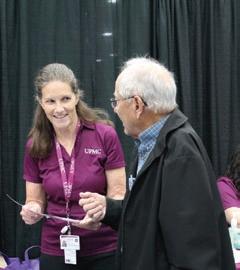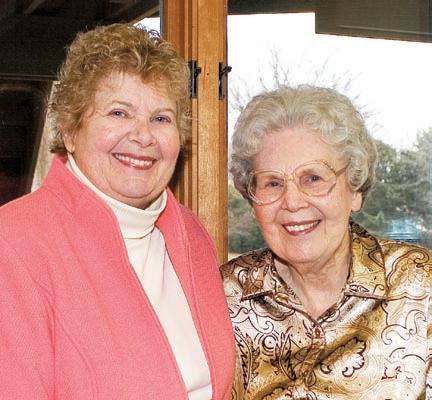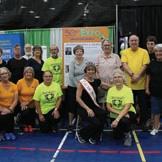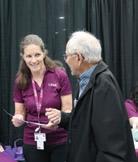
















Q. I know I have an enlarged prostate. Is this a sign of cancer?
Most men with enlarged prostates don’t develop prostate cancer, but there’s a lot more to this question.
The prostate is a walnut-size organ that surrounds the tube (urethra) that carries urine from the bladder. The urethra also transmits semen, which is a combination of sperm plus a fluid the prostate adds.
Benign prostatic hyperplasia (BPH) is the term used to describe an enlarged prostate, which is common in men 50 and older. An enlarged prostate may squeeze the urethra, making it hard to urinate. It may cause dribbling after you urinate or a frequent urge to urinate, especially at night.

Some men with prostate cancer also have BPH, but that doesn’t mean the two conditions are always linked. However, because the early symptoms are the same for both conditions, you should see a doctor if you have these symptoms.
The following are other symptoms of prostate problems: blood in urine or semen, burning urination, difficulty getting an erection, painful ejaculation, and frequent pain or stiffness in the lower back, hips, or upper thighs.
Treatment choices for BPH include:
Observation. If your symptoms don’t bother you a lot, your doctor may suggest that you delay treatment and come in for regular checkups.
Alpha-blockers. These are medicines that can relax muscles near the prostate and ease symptoms.
Finasteride (Proscar). This medication acts on the male hormone (testosterone) to shrink the prostate.
Surgery. An operation can relieve symptoms, but it can cause complications.
Prostate cancer is one of the most common types of cancer among American men. Treatment for prostate cancer works best when the disease is found early.
In a physical exam, the doctor feels the prostate through the rectal wall. Hard or lumpy areas may mean that cancer is present.
Your doctor also may suggest a blood test to check your prostate specific antigen (PSA) level. PSA levels may be high in men who have an enlarged prostate gland or prostate cancer. PSA tests are used for early cancer diagnosis, but PSA test results alone do not always tell whether or not cancer is present.
When doctors suspect cancer, they also may perform a biopsy. Doctors can take out a small piece of the prostate and look at it under a microscope. There are many options for treating prostate cancer:
Observation. If the cancer is growing slowly, you may decide to wait and watch.
Hormone therapy. This stops cancer cells from growing.
Surgery. There are several surgical options. These include radical prostatectomy or removal of the entire prostate, cryosurgery that kills the cancer by freezing it, radiation therapy to shrink tumors, and implant radiation that places radioactive seeds into the prostate.
Surgery can lead to impotence and incontinence. Improvements in surgery now make it possible for some men to keep their sexual function.





COrPOr ATE OFFiCE
P.O. Box 8049, Lancaster, PA 17604
Phone (717) 285-1350
Fax (717) 285-1360
Email address: info@onlinepub.com
Website address: www.onlinepub.com
PrESiDENT AND PUBLiSHEr
Donna K. Anderson
EDiTOriAL
Vice President and Managing Editor
Christianne Rupp
Editor, 50plus Publications
Megan Joyce
ArT DEPArTMENT
Project Coordinator
Lauren Phillips
BUSiNESS DEVELOPMENT
Senior Marketing Consultants
Joshua Binkley
Events Manager
Kimberly Shaffer
ADMiNiSTr ATiON
Business Manager
Elizabeth Duvall





50 plus Life is published by On-Line Publishers, Inc. and is distributed monthly among senior centers, retirement communities, banks, grocers, libraries and other outlets serving the senior community.
On-Line Publishers, Inc. will not knowingly accept or publish advertising which may be fraudulent or misleading in nature.
Views expressed in opinion stories, contributions, articles and letters are not necessarily the views of the publisher. The appearance of advertisements for products or services does not constitute an endorsement of the particular product or service. The publisher will not be responsible for mistakes in advertisements unless notified within five days of publication. On-Line Publishers, Inc. reserves the right to revise or reject any and all advertising. No part of this publication may be reproduced or reprinted without permission of On-Line Publishers, Inc.
We will not knowingly publish any advertisement or information not in compliance with the Federal Fair Housing Act, Pennsylvania State laws or other local laws.
By Lynda Hudzick
Jan Morrow of Harrisburg is an absolute whiz with a crochet hook.
“I learned when I was 19,” she said. “I was working at the liquor control board at the time, and someone there taught me to knit and crochet. But I prefer crocheting; I find knitting a little too cumbersome for me.”
Since that time she has made lap blankets for nursing homes, blankets and afghans for her children and grandchildren, and even Christmas tree skirts.
But these days she spends most of her crochet time creating individualized “pet pads” for the cats at the Harrisburg Humane Society as a cozy source of comfort while they’re waiting for their forever homes.
“My cousin was making these pet pads for the Gateway Humane Society in DuBois, and I though, ‘Oh, I can do that,’” Morrow said.
“So I made a few for the Harrisburg Humane Society, and they said the cats loved them — could I make more? They put them in the crates for the cats to sleep on, and when the cats get adopted out, they get to take their own pet pad with them.”
A pet pad is a small, single-layer crocheted blanket that is about 15 inches square.
“I crochet corner to corner,” Morrow said. “If I don’t do anything else but crochet, I can make one in about two days.”
camper in DuBois, Pennsylvania, and found that crocheting helped keep her mind occupied during those trying days.




During COVID, Morrow spent most of her time from March through September 2020 at her
“I made about 70 pet pads, working off and on, during that time,” she said. Morrow likes to get creative with the color combinations and designs.
“Every cat is unique, so every pet pad should be unique too,” she said.
Having made thousands of them over the last 20 years or so, you might think she would run out of yarn, but Morrow said, “There’s no problem with yarn. People give it to me, or I buy it at thrift stores and yard sales.
“A woman bought a camper at the campground where I go in DuBois, and cleaning out the shed, she found boxes and boxes of yarn that she gave to me. I have so much yarn — it’s going to outlive me for sure!”
A lifelong animal lover, Morrow has always had cats as pets, and currently she has three that “go everywhere I go,” she said. “I just love them; they’re my family.
“When I take the pet pads to the Humane Society, I can’t go in because I just want to take all the cats home with me! So I just drop them off with the staff. They understand. People call me the crazy cat lady — and that’s OK with me.”
Morrow recalls that the gifting of the personalized pet pads to the new owner of an adopted cat started with a Christmas promotion years ago at the Humane Society.
“They advertised that anyone who adopted a cat got to take the pet pad with them since it belonged to that particular cat
— people loved that! So when they asked me if I minded if they kept doing it, I said it was no problem. I can easily keep making them.”
An avid traveler, Morrow isn’t really able to do any scheduled volunteer work on a regular basis, but making pet pads is something she can do on the go and feel good about, knowing she is making a difference.
Her one-of-a-kind pet pads are not for sale; she only creates them to be given away.
“It’s not just the cats at the Humane Society that like them,” she said. “My cats love them too. I’ve usually got two or three going at a time because my cats insist on sitting on one while I’m working on another.”


In addition to her travels, and her work on the pet pads, Morrow also keeps busy by working as a nationally ranked gymnastics judge.
“My daughter did gymnastics from the time she was 5, and then my granddaughter did,” she said. “I was at a meet one time while my daughter was practicing, as I often was, and one of the judges asked me if I would be interested in becoming a judge myself. I said, ‘Why not? I’m here all the time anyway!’”
Morrow had to study the rules of the sport and was tested on her knowledge — and she passed easily.
“So I started judging high school meets, and one of the coaches from the club competitions said, ‘Why aren’t you judging private club meets?’ So I took the test for that, and that’s what I still do.”
She has traveled to several neighboring states to judge. Since 2009, Morrow has enjoyed traveling to Trinidad every year to judge a national competition.
“It’s a great experience,” she said. “I stay with friends there, and we just have a great time.”
As many folks who judge or referee high school, college, and club sports can attest, being an official can have ups and downs. Morrow is no stranger


to those sometimes uncomfortable interactions with overzealous fans.
“It’s very competitive, and people do sometimes get a little crazy and would come up to us, questioning our decisions, but over the last few years, new rules have been put in place to put a stop to that. It has helped a lot.”
Morrow has to be retested every four years to keep her national ranking as a judge, and although she really enjoys doing it, she said, “I’m getting a little older now, so I’m not sure now long I’ll keep it up.”
Nevertheless, Jan Morrow isn’t likely to put down her crochet hook anytime soon. Crocheting allows her to keep her creative juices flowing and gives her a real feeling of accomplishment — she knows how much the pet pads add a personal touch to help the cats feel loved.
“Plus,” she said, “it keeps me out of trouble!”
Are you a Lancaster County resident who is 55 years and older seeking full or part-time employment? e 55 + Job Bank program through the Employment Unit at the Office of Aging offers various employment possibilities to meet your goals. Based on an evaluation of your skills and abilities, we can match you with a position needed by a local employer. Some employers are specifically looking for mature workers because of the dependability, reliability, and experience they bring to the workplace. Full-time and part-time positions require varying skill levels and experience, with a wide range of financial compensation. Interested candidates should contact the Office of Aging Employment Unit at 717-299-7979 or by email aging@lancastercountypa.gov

Not only does September typically usher in college football season, those last-minute summer vacations, and the beginnings of fall-like weather in some parts of the U.S., but the month also happens to celebrate one of our favorite foods: honey!
Did you know that National Honey Month is just as much about honeybees as it is the honey they make?
The National Honey Board has always recognized the importance of honeybees and the benefits of honey, so in 1989, the NHB worked with the U.S. Department of Agriculture to give honey the praise its due.
September was officially deemed National Honey Month because it is the month when the majority of honey is harvested in the United States.
Honey is a one-ingredient recipe made by bees, flowers, and Mother Nature herself. Honeybees visit millions of blossoms in their lifetimes, making pollination of plants possible and collecting nectar to bring back to the hive.
Lucky for us, bees make more honey than their colony needs, and beekeepers remove the excess and bottle it, just like they’ve been doing for centuries.

Honey is said to be nature’s gold. It has antibacterial and antifungal properties and acts as a prebiotic, helping feed the good bacteria in your digestive system to keep your gut healthy.
Honey has even been touted as a way to speed up wound healing and soothe a sore throat. A thin coat of honey can be applied on the skin to disinfect and heal minor skin wounds and chapped lips.
Research has shown that honey contains a wide array of vitamins, minerals, and amino acids. Flavonoids and phenolic acids, which act as antioxidants,
Honey Muffins
Recipe courtesy of Mitzi Dulan, RD, CSSD, made for the National Honey Board (honey.com)
• 1 cup milk
• ½ cup sugar
• ½ cup strained honey
• 3 cups sifted flour
• 3 tsps. baking powder
• ¾ tsp. salt
• 3 eggs, well beaten
• ¼ cup melted shortening
1. Blend the milk, honey, and sugar, stirring very thoroughly.
2. Combine the sifted flour, baking powder, and salt.
3. Add the eggs and shortening and mix very lightly but quickly.
4. Bake in well-greased muffin pans at 375 degrees F for about 20 minutes.
are found in honey. The amount and type of these compounds depend largely on the floral source.
Honey is a versatile staple to keep in the kitchen: It can be used as a substitute for sugar in recipes, drizzled into your tea, or spread on biscuits. Compared to sugar, honey has more vitamins and minerals, is sweeter, and raises one’s blood sugar more slowly. If you buy locally made honey, it is unrefined and natural.
Honey is now considered good for oral hygiene; it is thought to have a calming effect on the mind and promotes sleep, too. Honey also helps indigestion and has sometimes been used to treat cardiovascular disease and respiratory complaints.
For relief of asthma, bronchitis, and other respiratory problems, mix 1 teaspoon of finely chopped thyme in a little honey. Take the mixture orally as needed to soothe inflamed lungs and airways.
Honey has also been recommended for those who suffer from hay fever. The hay fever sufferer is advised to eat honey that is harvested locally. This helps build immunity to local pollen by ingesting honey made from it.
Today, most of our honey comes from bee farmers. In the middle of the 19th century, L.L. Langstroth invented a movable frame hive that increased honey production throughout the U.S.
Today, it is estimated there are 5 billion colonies of bees in this country, including wild and raised. There are approximately 211,600 beekeepers in the U.S. with over 3 million commercial honey-producing colonies. Utah is called the Beehive State.
So, as you enjoy honey in your tea or baked goods, remember to thank the bees!
Nancy J. Schaaf, a retired RN, worked as a school nurse, a nurse supervisor at a men’s prison, and a health educator. She earned her BSN at Edinboro University. She is a freelance writer whose health articles appear in magazines throughout the U.S. and Canada. She can be reached at nancyjschaaf@gmail.com.

WSA addresses the unique challenges that well spouses face every day. If you could benefit from this information, please join us!
Meetings held 2nd & 4th Wednesdays of the month 7:00 p.m. – Wegmans, 2000 Crossings Blvd., Lancaster, PA 17601
















Across 1. Overdue 5. Kind of ray 10. Madame Bovary 14. Quaint outburst
15. Separated
16. Penthouse feature 17. Camera setting
18. Magazine, e.g.
20. Stroke
21. Suffix with lion
22. Carved
23. CD predecessors
25. Landing craft (abbr.)
26. Spires
31. Refines, as ore
35. Millinery
36. 1961 space chimp
38. Venerate
39. “Now I get it!”
40. Leatherworks
42. Relief
43. Back biter
45. Wing (Fr.)
46. ___ meridiem
47. Came across as
49. Detergent
51. Compass pt.
52. Cousin of “phooey!”
53. Light source
56. Some name suffixes
58. Bank letters
61. Justice of the peace
63. Highlands hillside
64. Hopped off
65. Buenos ___
66. Gumbo ingredient
67. Gambit
68. Meager
69. Attention-getter
1. Ballet move 2. Tropical fever 3. Blabbermouth 4. Shogun’s capital
Openings 6. Emulators 7. Calendar abbr. 8. Med. pics 9. Coral reefs 10. Booted out
Cheese nibblers 12. Beowulf beverage
Saddler’s tool
Consternation Down
21. Psychic power
24. Anatomical foot
26. Pillow covers
27. Western resort lake
28. Thompson of Howard the Duck
29. Sicilian resort
30. Kind of boom
32. Usurers
33. Shopworn
34. Passover feast
37. Peddle
40. Fashions
41. Sandpiper
44. Motel ice, e.g.
46. Santa ___, Calif.
48. Some river features
50. Bodybuilder’s pride
53. Summon
54. Exchange premium
55. Speed skater Heiden
56. Nana star Anna
57. Medical advice, often
59. Swabbies
60. Cold cuts, e.g.
61. Blueprint
62. Coach Parseghian
63. Conk

Dear Savvy Senior,
How can I tell if the health info on a website is trustworthy? I usually do a Google search on a symptom, drug, or health condition when I want to research something, but with so much information out there, I’m not sure what I can trust.
– Skeptical Sal
Dear Sal,
You’re wise to be skeptical! There’s an overwhelming amount of health advice on the internet today, and it can be hard to tell what’s credible.
To help you sort through the online clutter and locate reliable, trustworthy health information, here are a few tips to follow, along with some top-rated sites you can turn to with confidence.

First, know that Google or Bing is not always the best place to start a search. You’ll increase your odds of finding reliable health information if you begin
with websites run by government agencies (identified by URLs ending in .gov), medical associations (often .org), or academic institutions (.edu).
Commercial websites (usually ending in .com), such as drug or insurance companies who may be trying to sell you their products, are usually not the most trustworthy options. To find out who’s sponsoring a site and where the information came from, click on the “About Us” tab on the site’s homepage.
Also note that good health and medical information changes all the time, so check the date that information was published to make sure it’s current.
Some other areas you need be wary of include online symptom checkers and artificial intelligence (AI) tools. While symptom checkers do offer potential diagnoses that could fit your set of symptoms, they are often inaccurate and tend to err on the side of caution, says Ateev Mehrotra, MD, professor of healthcare policy at Harvard Medical School.
please see HEALTH on facing page


Let’s begin this review by soothing the feelings of cringing English teachers everywhere. Yes, we remember being taught that the plural of wolf is wolves. Just not here; Wolfs is not a typo.
A-listers George Clooney and Brad Pitt became a blockbuster buddy team with three beloved casino-heist films (Ocean’s Eleven, Ocean’s Twelve, Ocean’s Thirteen). The last time they frolicked together onscreen was in the 2008 comedy Burn After Reading, so it’s been a while (too long?) since the dynamic duo have cavorted at the multiplex.

Clooney and Pitt are no doubt the Newman and Redford of modern times. Still GQ -model hot at 63 (Clooney) and 60 (Pitt), these two have proven themselves more than just pretty faces, as the pair have earned their Hollywood stripes by the amassing of five highly coveted Academy Award Oscars — three for Pitt and two for Clooney.
A “fixer” here is someone illegally hired to conceal a high-profile crime. We meet our first nogoodnik in the character of Jack (Clooney), who is shown snapping on gloves in preparation for covering up a grisly murder.
“There’s nobody who can do what I do,” he asserts, just moments before Nick (Pitt) enters the scene and snaps on his own gloves. (Nick is even dressed much like Jack.) It seems that this second hunky fixer is equally skilled in clandestine endeavors.
As it turns out, both men are working the same assignment, and eventually
AI tools, like ChatGPT, can also be wrong or generate false but scientificsounding information.
You also need to be cautious about using medical information from social media, online forums, or YouTube. Comments in these places may sound authoritative even if the authors have no medical training or expertise.
While there are many excellent websites that provide reliable health and medical information, one of the best all-purpose sites that’s recommended by Consumer Reports for researching symptoms and conditions is MedlinePlus (medlineplus.gov).
A service of the National Library of Medicine, the world’s largest medical library, and part of the National Institutes of Health, MedlinePlus provides highquality, trustworthy health and wellness information that’s easy to understand and free of advertising.
Here are a few additional websites, recommended by the Medical Library Association and others, to help you find reliable information on specific diseases, conditions, and treatments.
Cancer: National Cancer Institute (cancer.gov), American Cancer Society (cancer.org), and National Comprehensive Cancer Network (nccn.org)
the two lone-wolf workers are forced to form an unlikely partnership, which finds them leaping feet-first into a convoluted night-long web of intrigue, double-crosses, and absurd situations, many of which are fraught with danger and possible death.
Cars roar recklessly through crowded New York City streets, fierce gun battles transpire, and flying fists keep the action constantly on sizzle and our attention riveted.
Along the way, though, we see that the story itself is unfolding at a rather leisurely pace, which allows for greater character development of the twosome; thus, we are given ample time to witness their growing and palpable chemistry.
The supporting cast of Amy Ryan, Austin Abrams, and Poorna Jagannathan provide a healthy dose of flair to the mix in this quirky action-comedy.
Jon Watts (Spider-Man) wrote and directed the Columbia Pictures project.
“We had a blast doing it,” says Clooney. “It’s an off-the-charts great film, and it was fun to work with Brad again.”
The two are reportedly in talks about an eventual sequel.
Wolfs, an imaginative visual stew of humor, suspense, and more twists than a bowl of pretzels, opens Sept. 20.
Randal C. Hill enjoys getting sneak peeks of forthcoming movies from his home on the Oregon coast. He can be reached at wryterhill@msn.com.
Heart disease: American Heart Association (americanheart.org) and National Heart, Lung, and Blood Institute (nhlbi.nih.gov)
Diabetes: American Diabetes Association (diabetes.org)
Alzheimer’s disease: Alzheimer’s Association (alz.org) and Alzheimers.gov
Public health and vaccines: Centers for Disease Control and Prevention (cdc.gov)
Alternative medicine: National Center for Complementary and Integrative Health (nccih.nih.gov) and the National Institutes of Health’s Office of Dietary Supplements (ods.od.nih.gov)
With any research you do online before seeing a doctor, be sure to save it or print your findings out on paper, including the site you got your information from, so you can review it together.
Send your senior questions to: Savvy Senior, P.O. Box 5443, Norman, OK 73070, or visit savvysenior.org. Jim Miller is a contributor to the NBC Today show and author of The Savvy Senior book.

In the 30 years I’ve written about senior dating and relationships, I’ve heard from many readers. Recently, five women aired their thoughts about losing love and dealing with the pain. I share them with you today.
Carolyn emailed, “‘Life is for the living!’ We remember the good times and the love we shared with our mate who has passed on, but it is necessary to find another companion.
“I lost my close friend and companion on April 10, 2020. He contracted COVID-19 before authorities knew what was killing people so rapidly.
“I am now seeing a man who is nice, treats me well, buys me flowers and books that I like, and takes me to Broadway shows. He makes me laugh so much. His wife also passed away. He said right off the bat that he

didn’t want to remain lonely anymore. Neither did I. We are together.”
Pat wrote, “I was widowed at age 53 in 2000 after 32 years of marriage. The following September my daughter gave birth to identical twin girls. So, I had something to focus on after losing my husband (I was a caregiver for many years, as he had MS).
“When my granddaughters became teenagers, I found I needed more in my life and joined a dating site. I dated two men, each for two years, but I knew there had to be someone out there that I could really connect to. So, I kept at it — it was like a job.
“I recognized the scammers and finally met an honest man who lives 15 minutes from me. He is a widower. We started dating. Now, two years later, we are happy together. I would never have met him if it hadn’t been for the senior-dating website.”
Deanne wrote, “For 33 years I was a party of two. We were the dynamic duo, and the word ‘lonely’ didn’t exist. I just can’t seem to get used to being without someone who was such a big part of me.






“And not having someone to talk to, laugh with, and share life with is the worst pain I’ve experienced because it’s never-ending. This comes from a girl who experienced a Caesarean section with no anesthesia and lived to talk about it. My pain threshold is high, and surgery heals, but I can’t seem to heal my heart.”
Thyrza emailed, “Loneliness is terrible. It has taken me 10 years to get the courage to start looking. My oldest daughter nudged me to give myself a chance.
“I found a man on Match.com. It just takes patience and an open mind to find that person. To me, there is no timeframe in which to find a new relationship. Looking back, I wish I’d had a different mindset then. Ten years is a long time to realize that loneliness sucks. Sooner is better!”
Dee shared, “I understand the need to find love again. I don’t want to just be friends, although it could start that way. At my stage in life, I want warp speed.
“I work late so I don’t have to be home as the sun sets (just too many memories for me). This is not the life I planned, this is not what I could have ever imagined happening, and I want a new beginning.
“I would like to find a special person to walk alongside me, hold my hand, and make me feel good again. And a hug, wow — with that strong arm around me. Yes, I’m truly missing that. If I’m lucky enough, I will kiss loneliness goodbye.”
My best wishes to these five courageous women.
For dating information, previous articles, or to sign up for Tom’s complimentary, weekly e-newsletter, go to findingloveafter50.com.



















The 50 plus EXPO, central Pennsylvania’s one-day information and entertainment event focused on the 50-plus community, will return to Lancaster County this fall.
The 28th annual Lancaster County 50 plus EXPO (Fall) will be held from 9 a.m. to 2 p.m. on Wednesday, Sept. 18, at Spooky Nook Sports, 2913 Spooky Nook Road, Manheim.
Hosted by OLP EvEnts and the Lancaster County Office of Aging, the EXPO’s exhibitors will provide up-to-date information focused on the health, lifestyle, and needs of the local 50-plus community.
Admission and parking are free. Charles F. Snyder Funeral Home & Crematory will be providing free shuttle transportation through the parking lot to the EXPO entrance.
In addition to no-cost health screenings, guests can enjoy onstage entertainment and seminars, including an interactive fitness demonstration with Bright Side Opportunities Center; a presentation on Medicare by Highmark Blue Shield; estate-planning guidance from Bellomo & Associates; and a performance by national award-winning Elvis Presley tribute artist Jeff Krick Jr.
In the parking lot, AAA will have its Mobile Branch cargo van set up for help with many AAA services.
Sponsors include 50 plus Life, Age in Place Homecare, Bellomo & Associates, Blue Ridge Communications, BUSINESSWoman, Capital Blue Cross, Highmark Blue Shield, Landis Communities, LCTV, Madden & Gilbert Physical Therapy, WellSpan Health, WHTM abc27, WHYF AM720, and Sweet 16 WPDC, The Oldies Station.
For updates, please visit 50plusExpoPA.com.













9:45 a.m. – You’re Never Too Old, and It’s Never Too Late to Start
Presented by Sally Winchell, Wellness Director, Bright Side Opportunities Center, and Ms. Pennsylvania Senior America 2023
Join Sally, along with her Bright Side seniors, for an inspiring and interactive exercise session designed to boost your strength, balance, flexibility, and cognitive skills. Discover how strength training and eating a healthy diet is the keystone to healthy senior years. Sally will show you how to stay strong, energetic, and actively engaged in life!

11:15 a.m. – Secure Your Loved Ones and Assets: Essential Estate-Planning Tips
Presented by Jeff Bellomo, Esquire, Bellomo & Associates
Discover how proper estate planning can avoid family disputes, minimize delays and costs, and keep control of your assets. Attend this session to gain a solid understanding of estate planning and securing your legacy for future generations. Get expert answers to your questions, such as common mistakes made in estate planning.
AAA Central Penn
AAA gift bag ($175 value)
BeeCentral Technology
Smart home technology bundle and setup coupons ($150 value)
Dutch Apple Dinner Theater
Dinner show tickets ($170 value)
Etterling’s Adventures –
Dream Vacations
Travel bag ($100 value)
Highmark Blue Shield
Basket of health and wellness
items ($15 value)
HomeRite of Central PA
Lottery tree ($50 value)


10:30 a.m. – Medicare 101
Presented by Julissa Quinones, Member Engagement Guide, Highmark Blue Shield
Highmark Blue Shield’s “Medicare 101” seminar is designed to help you better understand Medicare and the various choices available when it comes to your benefits. Julissa will examine important dates, review coverage lingo, discuss plan options, explore the extra benefits Highmark provides, and show you how to enroll once you are ready.
Presented by Jeff Krick Jr.
In only his mid-20s, Reading native Jeff Krick Jr. is one of the most successful Elvis tribute artists in the country. At age 19, Jeff placed No. 6 in the world at the prestigious Ultimate Elvis Tribute Contest and in the top 10 at the Images of the King Contest in Memphis. A two-time fan-favorite award winner and three-time top 10 finalist at Maryland’s Ocean City Tribute Festival, Jeff has headlined cruise ships and numerous Elvis music festivals.
Lancaster County Career and Technology Center
Blood pressure cuff and pulse oximeter ($50 value)
Lancaster School of Cosmetology & Therapeutic Bodywork
Gift certificate ($25 value)
Manor House Apartments, Powder Mill Apartments, Springetts Apartments
Gift basket ($50 value)









Stop by AAA’s Mobile Branch cargo van for help with many AAA services, such as notary service, passport photos, theme park tickets, and more!

Medicare plans with $0 premiums, no deductibles, and dental included Connect with your local Licensed Medicare Advisor to learn more.


Highmark Blue Shield is a Medicare Advantage HMO, PPO, and/or Part D plan with a Medicare contract. Enrollment in these plans depends on contract renewal.Benefits and/ or benefit administration may be provided by or through the following entities, which are independent licensees of the Blue Cross Blue Shield Association: Central and Southeastern PA: Highmark Inc. d/b/a Highmark Blue Shield, Highmark Health Insurance Company, Highmark Choice Company or Highmark Senior Health Company. Northeastern NY: Highmark Western and Northeastern New York Inc. d/b/a Highmark Blue Shield. All references to “Highmark” in this document are references to the Highmark company that is providing the member’s health benefits or health benefit administration and/or to one or more of its affiliated Blue companies.
Y0037_23_3925_M 06/24 MX3622336
Total joint replacement for the sport of life. Joint pain shouldn’t put you on the sidelines. Our expert specialists have what it takes to get you back to what you enjoy.
Flu, COVID (if available), shingles, and pneumonia shots will be provided by South Central PA Medical Reserve Corps on a rst-come, rst-served basis at the 50plus EXPO.
Flu shots are no-cost for most people with Medicare Part B and most insurance plans. Please bring your insurance card.
Sept. 18
9 a.m. – 2 p.m.
Spooky Nook Sports 2913 Spooky Nook Road Manheim LANCASTER COUNTY
If you can remember actually dialing a phone and walking across the room to change the TV channel, we’ve got the radio station for you.

Elizabethtown’s own radio station is back on the air with a new format. Six decades of great music downloaded to one radio station and set on shuffle.
VisionCorps, a nonprofit with a goal of empowering people who are blind or vision impaired, is looking for volunteers.
“Since the pandemic, the number of people volunteering is declining, and we are looking for more people to help us,” said Dennis Steiner, president and CEO of VisionCorps.
“Our volunteers play an important role — they often help drive people who are blind or vision impaired to different destinations, and we depend on them.”
Steiner said volunteers are needed to drive employees and clients with low vision to different destinations in the five counties served by VisionCorps: Lancaster, Adams, Chester, Lebanon, and York.
The organization serves almost 2,000 individuals with rehabilitation services in those areas.
Volunteers can use their own vehicles or drive VisionCorps’ company cars. Assignments can range from short to longer appointments and could take place in an urban or rural setting.
They are given choices for their assignments and can choose to participate when it is convenient for them.
Persons interested in volunteering or finding out more should contact Linda at lconyers@visioncorps.net or (717) 205-4116.





Alzheimer’s disease is the sixth-leading cause of death in the United States and the fifth-leading cause of death for individuals age 65 and older. This devastating and debilitating disease is the ultimate thief — of memories, independence, control, time, and, ultimately, life.
And the disease is often dealt with in silence. Those facing the disease feel a stigma surrounding their diagnosis and often don’t seek the support they need.
At the Alzheimer’s Association, we hear from individuals daily that they “feel alone.” Family and friends stop visiting because of “abnormal” behavior — a symptom of the disease — and caregivers become more and more isolated.
We want those diagnosed with Alzheimer’s and their families to know that there is hope, and there is help, through the Alzheimer’s Association of Greater Pennsylvania Chapter.
There are more than 6 million Americans currently diagnosed with Alzheimer’s disease or a related dementia and more than 15 million caregivers. In Pennsylvania alone, there are more than 400,000 individuals diagnosed with Alzheimer’s or related dementia.
We are here to provide education and support to the millions who face dementia every day, while advancing critical research toward methods of treatment and prevention, ultimately to end Alzheimer’s disease.
We also host the Walk to End Alzheimer’s. This is the association’s largest annual awareness and fundraising event, which occurs every fall.
At the Alzheimer’s Association Walk to End Alzheimer’s, we’re fighting for a different future. For families facing the disease today. For more time. For treatments. We’re closer than ever to stopping Alzheimer’s.
But to get there, we need you. Join us for the world’s largest fundraiser to fight the disease.
Register today at alz.org/gpawal k or call our Helpline, available 24 hours, seven days a week, at (800) 272-3900.
Local walks include:
Saturday, Sept. 21
Overlook Park, Lancaster
Registration at 9 a.m., walk at 10 a.m.
Saturday, Oct. 26
John C. Rudy Park, York
Registration at 9 a.m., walk at 10 a.m.
Saturday, Nov. 2
City Island, Harrisburg
Registration at 9 a.m., walk at 10 a.m.



September 21, 2024
Overlook Park, Lancaster
Registration at 9:00 a.m. • Walk at 10:00 a.m.
October 26, 2024
John C. Rudy Park, York
Registration at 9:00 a.m. • Walk at 10:00 a.m.
November 2, 2024
City Island, Harrisburg
Registration at 9:00 a.m. • Walk at 10:00 a.m.
Easy online registration at www.alz.org/gpawalk.
• Volunteer opportunities available.
• Teams and individuals welcome.
Registration brochures, team packets, and sponsorship packets available. For more information, please contact:
Harrisburg, Lancaster, and York Walks Asheleigh Forsburg (717) 678-6463 x1791; aforsburg@alz.org
Alzheimer’s Association
2595 Interstate Drive, Suite 100 • Harrisburg, PA 17110

By Kimberly Blaker
Like many seniors and retirees today will attest, you’re never too old to go to college. Lifelong learning has become increasingly popular in recent years as baby boomers have reached the age of retirement.
For some, the purpose of going back to school is to finish their studies and accomplish a degree. But for many more, it’s merely for fun and an opportunity to gain knowledge, discover new interests, and keep their minds and bodies fit.
If you’d like to go to college, first, consider your purpose and what you hope to accomplish. Do you want to earn your degree? Are you primarily interested in broadening your knowledge? Are you in search of new interests and socializing opportunities?

Your answer might be one or all of these. But knowing your purpose will give you direction.
Once you’ve determined what you hope to achieve, visit nearby colleges or explore the websites of colleges in the city or state where you’d like to settle for retirement, and see what they have to offer.
If earning your degree is important to you, today, more and more accredited colleges offer a variety of options for earning nontraditional course credit. Look into this first to save time and money.
At some colleges, you can earn Self-Acquired Competency (SAC) credits, which may have different names at various institutions. Such credits are available for a wide range of skills and life experiences.
They require compiling a portfolio for faculty evaluation. In your portfolio, you can include on-the-job training, work and volunteer experience, workshops, seminars, and more.
If you served in the military, you might be eligible for Military Service Credit for education you gained through schools, experience, or service.
You can also earn credits by examination. Some of these include:
• Credits for College-Level Examination Programs (CLEP)
• Advanced Placement examinations (AP)
• Defense Activity for Non-Traditional Education Support (DANTES)
Credit by examination can also save time and money if you have knowledge in a particular area or if you study and test well. But be sure to check with your institution before enrolling, since credit may not be awarded following admission.
Another possibility for credits is if you’ve completed any noncollegiate or incompany sponsored programs or courses. Find out if those programs or courses are any of the thousands reviewed by the American Council on Education (ACE). If so, ask your academic institution if they award credits based on ACE recommendations.
Independent study programs offer a couple of options. You can take online courses in the convenience of your home. These usually require attendance (at your computer) at specific times.














Correspondence courses are a good option also because there are no schedules. They typically allow six to 18 months for completion, with extensions up to one year. Evening and weekend courses, as well as accelerated programs, also offer some flexibility.




There are many options for financing your education. The Federal Pell Grant is available regardless of your age and is awarded based on financial need. The maximum award amount for the 20232024 school year was $7,395. Several other options include:
• The Federal Supplemental Education Opportunity Grant (FSEOG)

Can you imagine a TV series changing the fortunes of a major business?
From 1977 to 1987, millions of television viewers set aside Saturday nights to enjoy Aaron Spelling’s ratings behemoth The Love Boat on ABC-TV.
As goes an old saying, nobody loved the show except the public. Critics detested it, citing corny jokes and absurd storylines. Some early cynics even predicted that Spelling’s offering would sink faster than the Titanic Wrong!
The Love Boat was based on a 1976 TV movie of the same name, which itself had been built around a 1974 book by former cruise director Jeraldine Saunders. She breathlessly claimed to witness numerous lovey-dovey stories while asea.
Each of Spelling’s more than 250 hour-long episodes usually presented three separate story arcs, with numerous celebrity actors having their issues resolved just before the credits rolled.
Hundreds of famous folks made guest appearances, and the show’s success also allowed Spelling a personal side benefit: “I was able to fulfill my own dreams by hiring some of the great old Hollywood legends as guest stars. The studios weren’t banging their doors down with offers, but these actors still had lots of talent, and I was happy to provide an outlet.”

Such VIPs from Tinseltown’s golden years included Lana Turner, Olivia de Havilland, Shelley Winters, and Ginger Rogers.
Each episode brought together the ensemble cast of Captain Stubing (Gavin MacLeod), the onboard doctor Adam Bricker (Bernie Kopell), cruise director Julie McCoy (Lauren Tewes), bartender Isaac Washington (Ted Lange), and purser “Gopher” Smith (Fred Grandy).
COLLEGE from facing page
• The Federal Work Study program
• The Federal Perkins loan
• Federal subsidized Stafford loan
• Federal unsubsidized Stafford loan
Many scholarships are also available for seniors, so ask the academic institutions you’re considering what they offer.
If you’re still in the workforce, ask your employer if it offers reimbursement for college courses. If the classes relate to your job, your employer may cover the costs.
Finally, don’t forget the American Opportunity Tax Credit, which modifies the HOPE Credit, a tax credit available for eligible taxpayers, totaling up to a maximum of $2,500. There’s also the Lifetime Learning tax credit. Specific requirements and restrictions apply.
Together the crew steered the high-seas celebrities toward romance-drenched situations by igniting PGrated new romances or salvaging faltering alliances.
Some of the show’s scenes were filmed during actual voyages on Pacific Cruises’ Pacific Princess, as well as two sister ships, the Island Princess and the Sun Princess. Real-life passengers were often used as extras rather than professional actors.
Then there was that iconic theme song, recorded by crooner Jack Jones — best known for “Wives and Lovers” — with his The Love Boat becoming a Top 40 single.
In 1970, about half a million people took cruises. Within three decades, that number had zoomed to 5 million, thanks in large part to the exuberant interest brought about after The Love Boat showcased the glamorous world of ocean cruising.
One of the show’s scriptwriters, Michael L. Grace, said, “The Love Boat really created the industry. You had 50 million people watching, and they all wanted to go on a cruise.”
To cater to the sudden rush of interest, a boom in cruise-ship building exploded in full force by the early 1980s and continued well into the next decade.
Gavin MacLeod once explained, “People always ask us why The Love Boat was so popular. I always say it gave people something to dream about. They would dream about being out on the open seas on a cruise and discovering the world’s greatest destinations, dreaming about love, and, of course, happy endings, since the shows always ended on a high note.”
Although Randal C. Hill’s heart lives in the past, the rest of him resides in Bandon, Ore. He can be reached at wryterhill@msn.com.
If you aren’t interested in pursuing a degree but want the opportunity to attend courses, many colleges also offer special rates to seniors to audit a class.
Kimberly Blaker is a freelance writer. She also owns an online store, Sage Rare & Collectible Books, specializing in out-of-print, scarce, signed, and first editions; fine bindings; ephemera; and more at sagerarebooks.com
• Visit Fast Web for information on colleges and a scholarship search at fastweb.com
• For federal grants and loans, request your Student Guide by calling (800) 433-3243 or visit studentaid.ed.gov/resource s
• Visit the U.S. Department of Education for information on tax credits at studentaid.ed.gov/types/tax-benefit s

Early natural fibers were limited to silk, wool, linen, animal hair, and the flax plant. Cotton sewing thread was created in 1812 by Patrick and James Clark.
The innovation of manmade fibers, meaning created in a laboratory from chemicals, revolutionized the apparel and home furnishing industries. How did this evolve, and where are we today?
In 1664, English naturalist Robert Hooke predicted a fiber “if not fully as good, nay better” than the fiber produced by the silkworm.
Nearly 200 years later in 1855, a Swiss chemist, Georges Audemars, used the fibrous

Worn-out nylon and silk stockings were reprocessed and made into parachutes for army fliers, towropes for glider planes, and other war material, circa 1942.

84% of Baby Boomers have taken action as a result of seeing an ad in a print newspaper in the past 30 days. 2

A model in a hand-printed Lastex swimsuit by Alix of Miami, 1958.
inner bark of a mulberry tree as his source of cellulose to make artificial silk. He formed threads by dipping needles into the solution and drawing them out.
In the 1880s, Sir Joseph Swan extruded this cellulose solution through fine holes to produce silk threads. He developed this technique to produce filaments for the new electric lamps. In 1885, Swan exhibited fabrics crocheted by his wife from this new fiber, but he did not pursue its textile possibilities.
In 1889, a French chemist, Count Hilaire de Chardonnet, produced an artificial silk yarn called rayon that caused a sensation at the Paris Exhibition.
In 1924, the Celanese Company began commercial textile production of acetate fiber. In 1931, an American DuPont chemist, Dr. Wallace Carothers, created a new miracle fiber, nylon — the first fiber synthesized completely from chemicals. It was strong and elastic. Initially it was used as surgical thread, bristles for toothbrushes, and, famously, for nylon stockings.
First shown in 1939 at the San Francisco World’s Fair, American women embraced the look and elasticity of nylon stockings. During World War II, nylon factories were repurposed to manufacture tents, tires, ropes, ponchos, and military supplies. Nylon replaced Japanese silk in parachutes and was even used in U.S. paper currency.
In the search for stretchable materials for clothing, a British engineer, Charles E. Lewis, invented Lastex in the 1930s. It incorporated elastic threads, often made of natural or synthetic rubber, interlaced with or covered by cotton thread.
Lastex provided moderate stretch and was quickly put into women’s undergarments for stretch and shaping. Known to be hot to wear, the military demand for rubber in the 1940s pushed the fabric industry to new alternatives.
Polyester was patented in 1941 by two British scientists. DuPont bought the rights to the patent in 1946 and began to sell it in textiles under the brand name Dacron. At this same time, DuPont produced acrylic, a synthetic fiber with wool-like characteristics.
1Coda Ventures; 2NAA Because in print or online, newspapers are the most trusted source of news and information among all age groups.1 To advertise your products and services, call 717-285-1350 or email info@onlinepub.com please see FiBErS on facing page
In 1952, “wash and wear” first appeared in a blend of 60% acrylic and 40% cotton. Triacetate arrived in 1954, making it possible to have crisp, permanently pleated fabrics. Spandex, a stretchable fiber created by DuPont in 1959, has been used in bras, girdles, and jockstraps, as well as swimwear and sportswear.
The 1960s introduced aramid fibers, also known as Kevlar or Nomex, which are lighter and tougher than steel, in addition to being fire- and
Researchers have found that 54% of older American Indians have cognitive impairment, including 10% with dementia, highlighting a significant disparity with the rates of cognitive impairment and dementia in the general American population.
The National Institutes of Health-funded study also identified vascular injury, which can result from untreated hypertension and diabetes, and Alzheimer’s disease as equally responsible contributors to dementia in American Indians, with substantial overlaps between the two.
The findings were published in Alzheimer’s & Dementia: The Journal of the Alzheimer’s Association
“These results underscore that cognitive impairment among elder American Indians is highly prevalent, more than previously thought,” said Amy S. Kelley, M.D., deputy director of NIH’s National Institute on Aging.

“Considering how these new prevalence figures for American Indians are much higher than other groups, as we continue to pursue prevention strategies and treatments, it is imperative that we address health disparities to help us find solutions that will work for all older adults.”
Previous studies that relied on medical records estimated that cognitive impairment and dementia levels in American Indians were similar to nonHispanic whites.
However, for this new study, the researchers used survey and screening techniques with individual assessments that did not rely on previous access to the medical care system.
They found that 216 American Indian participants aged 72-95 had some form of impairment.
Of those, 140, or 35.3%, of them had mild cognitive impairment, 41
FiBErS from facing page
electricity-proof.
By the late 1950s, nearly 30% of fibers used by American textile mills were manmade.
Today’s basic fibers had all been created. Fiber blending became widespread. The industry introduced modifications to the basic thread composition, resulting in flame-retardant, cling-free, soil-resistant, or anti-static properties.
In the 1970s, flammability standards, initially demanded for children’s sleepwear, were legislated.
In 2022 the worldwide production of textiles measured 113.8 million metric tons — 77% from chemical fibers, 22% from natural fibers.
Polyester makes up 54% of the chemical fibers, dominating the synthetic market with multiple blends. Its advantages include that it repels water, has more luster, does not disintegrate from contact with sunlight or other means, and it is cheaper to produce in bulk.
(10.3%) had dementia, and 35 (8.8%) had a different form of cognitive impairment that was not due to MCI or dementia.
There were 181 (45.6%) participants who showed no signs of cognitive impairment.
These results suggest the levels of MCI and dementia in American Indians who are 72-95 years of age are higher than those in other groups. Based on previous studies, researchers estimated MCI levels at 12% to 21% of non-Hispanic whites, 22% to 25% of Black Americans, and 20% to 28% of Hispanics/Latinos.
Vascular brain injury measures were seen more often than Alzheimer’s markers in the MCI cases, suggesting that both Alzheimer’s disease and vascular brain injury may have been drivers of cognitive impairment for many of the participants.
“This research also suggests that vascular risk factors, such as hypertension and diabetes, are known to be modifiable and therefore could be prioritized to potentially reduce the risk of cognitive impairment among American Indians,” said Dallas Anderson, Ph.D., M.P.H., an NIA program director and neuroepidemiologist.
Led by a team of scientists at the Huntington Medical Research Institutes in Pasadena, California, and University of Washington School of Medicine, Seattle, the study harnessed the data of 397 participants in the NIH-funded Strong Heart Study.
A population-based study of American Indian Tribes, the Strong Heart Study was conducted over 30 years and in three U.S. geographic regions — the Northern Plains, Southern Plains, and Southwest.
An ancillary study included detailed cognitive testing, neurological examination, and brain imaging during two visits approximately seven years apart.

Yet, the indestructible characteristics of synthetics have also brought them under criticism because they are not biodegradable. The fibers, basically created from petroleum and crude oil, can last for years.
Today’s reuse consciousness has encouraged the fashion industry to be ethical, environmentally friendly, and sustainable. This includes recycling materials, using biodegradable product solutions, sourcing raw materials ethically, and using more efficient manufacturing processes.
There is also renewed interest in natural fibers, including new hemp and bamboo fabrics.
What’s in your clothes?
Doris Montag is a homespun historian and an exhibit curator who researches and displays historical collections of ordinary things, such as can openers, crochet, toy sewing machines, hand corn planters, powder compacts, egg cartons, and more. Contact or follow her on Facebook, HistoryofOrdinaryThings. Calvin
dress, 1996-97.

During the late afternoon of June 10 of this year, I was on our lawn in New Holland enjoying sunsoaked green trees and shrubbery and listening to mourning doves and house finches.
Suddenly, two turkey vultures swooped low overhead and landed in a tall tree in a little patch of trees across the street from our house, probably to spend the night. I guessed for a couple of years that those vultures were roosting every evening in our area, but I didn’t know where until that moment.

After seeing those turkey vultures going to roost, I was reminded of other exciting wildlife I saw in that clump of trees through the years.
During evenings in August and September, I hear several male true katydids debating whether Katy did or didn’t. They chant that message with a file on one wing and a scraper on the other that they rub together to attract
Maintaining the independence and quality of life for Lancaster County’s aging population through information, protection, services, and community support
Support the older person’s right to decide his/her own destiny. Encourage consumer self-determination and choice.
Support the older person’s right to risk.
Promote independence and dignity.
Avoid unnecessary/inappropriate institutionalization.
females for mating.
Related to grasshoppers, katydids have large back legs for leaping. And katydids are totally green to blend into the foliage they also ingest in the treetops.
Some summer evenings I see a few bats swooping out of that patch of trees. Each silhouetted bat flutters and dives erratically after flying insects it consumes in mid-air. But soon it vanishes because it seeks other hunting skies for a night-long insect feast.
One evening the end of May one year, we saw a family of five beautiful screech owls perching stalwartly on the railing of our front porch. I think the young owls hatched in a hollow in a tree across the street and had just left their nursery for a night’s hunting of mice with their parents. They sure were cute the short time they were visiting us.
About Us – The Lancaster County Office of Aging (LCOA) was established 45 years ago as a result of the passage of the Older Americans Act. This act directed states to develop a network of services and supports to help keep older adults healthy and independent.
The Pennsylvania Department of Aging was created to fulfill this mandate. In turn, a network of 52 Area Agencies on Aging (AAA) was established throughout the commonwealth to carry out this mission at the local level.
Funding for aging-related services is a combination of state and federal monies, with the Pennsylvania Lottery providing the major source of funding.
In Lancaster County, the AAA is part of county government. We are dedicated to providing Lancaster County residents, 60 years of age and older, with a wide range of informational resources and services as well as advocacy efforts and elder abuse protection.
The LCOA offers the following services:
• Information and referral services
• Long-term living assessments
• Home and community-based support services
• Protection from abuse and neglect
• APPRISE, Medicare, and related health insurance counseling
• Senior center services
• Adult daily living services
• Caregiver support
• Employment
• Ombudsman services
• Transportation
• Legal services
• Health and wellness programming
• Volunteer opportunities
For more information, please call us Monday – Friday from 8:30 a.m. – 5 p.m. at 717-299-7979/1-800-801-3070, visit our website at www.lancoaging.org , or email aging@co.lancaster.pa.us.

Another year, from mid-May to the middle of June, I heard a male wood thrush singing lovely, flute-like notes in that stand of trees, off and on all day, every day. Since thrushes are woodland species, I was surprised to hear him in such a small clump of trees. But, I think he never attracted a mate to raise young there.
During September and October, gray squirrels and blue jays harvest acorns from a few pin oak trees in that patch of trees and stash many of them away for winter use. The jays’ blue feathers are exceptionally attractive among the red and brown oak foliage when those birds flash in and out of those striking trees.
One winter day, I saw two black vultures eating something on the ground under those trees. With binoculars, I saw they were sharing a dead gray squirrel.
It’s delightfully amazing the wildlife one experiences in any one place, over time. Readers can do that too, right at home.









By James Patterson
Many of the obituaries for Bob Newhart, star of the successfully creative CBS sitcom The Bob Newhart Show, focused on his unique approach to comedy.
His 1960 comedy albums The ButtonDown Mind of Bob Newhart and The Button-Down Mind Strikes Back caught the attention of the legendary star maker Ed Sullivan.
Among the many items that Newhart signed for me is a newspaper photo of Sullivan jokingly strangling the comic.
“To James, my friend in D.C.,” he wrote.
Despite a busy professional life, including TV and standup comedy that extended into his 90s, Newhart took the time to reply to his fan mail. This might have explained why he was such a successful and beloved comedian.
In 2022, Parade magazine featured Newhart on its cover. In the background were photos of the actor’s famous TV and film roles, including the 2003 film Elf. I sent him a copy of the Parade cover for him to sign for me.
He very sweetly signed, “To James, a good friend, from Papa Elf.”
Perhaps the most gratifying item Newhart signed for me was in response to a Christmas card.


“Thank you for the beautiful Christmas card. It was among the prettiest of the cards my family received,” he wrote.
Newhart’s films included Hell is For Heroes, Catch-22, and my favorite, Cold Turkey. In the latter film, a small town is offered a fortune if everyone can stop smoking. The cast included Dick Van Dyke, Edward Everett Horton, and Tom Poston.
In 1963, Newhart starred in a memorable episode of The Alfred Hitchcock Hour. Newhart played a henpecked husband attracted to a stripper. In “How

to Get Rid of Your Wife,” Jane Withers (1926-2021) played Newhart’s wife and lovely Joyce Jameson (1927-1987) was Newhart’s attractive stripper interest.
Newhart plays Gerald Swinney who, tired of being a henpecked husband, devises a plan to, as the title suggests, “get rid of his wife.” If you think that Newhart planned to murder his wife, you would be wrong. He has another plan in mind.
“How to Get Rid of Your Wife” is a very clever episode, and Newhart plays Newhart. His role is the same sitcom character that audiences loved, but in a Hitchcockian situation. If you have not seen the episode, prepare to be impressed. Withers is also very good.

The Alfred Hitchcock Hour and the 30-minute Alfred Hitchcock Presents can be seen on Peacock, a subscription-based streaming service where many fine older TV shows can be viewed.
Newhart had a unique gift of speaking in a halting way that appealed to audiences. In 2006, he wrote a well-received memoir, I Shouldn’t Even Be Doing This! After his death, the book returned to the bestseller lists.
In his memoir, Newhart explained his comedic way of speaking. It came naturally to him, he said.
“When I first performed, I didn’t study all the working comedians and say, ‘There is nobody stammering out there … What a great opportunity,’” he wrote, adding, “Truly, that’s … the … way I talk.”
Newhart received Emmys, Grammys, and, in 2002, a Mark Twain Prize for American Humor. He also received my fan mail. He generously replied. Thanks, Bob!
James Patterson is a writer in the Washington, D.C., area.




Biggie is a 4-year-old male rabbit who came to us through no fault of his own, after his previous family developed severe allergies to him.
Biggie is a pretty big guy, as his name suggests, so he is going to need an appropriately sized enclosure in his new home. He loves to munch on fresh fruits and veggies in his free time!
Biggie is a super-sweet guy looking for his forever home. Stop by and meet with him today!
Biggie’s ID number is 237491. Please send your application to the Lancaster Center for Animal Life-Saving at adoptlancaster@humanepa.org or give the shelter a call at (717) 393-6551 to learn more.
Villages at Greenfield (formerly Eastwood Village) offers:
Land Lease Community
High-quality manufactured homes on foundations
Covered Front Porches
Energy Star Certified
Landscape package included
Optional Garage / Storage Shed
Natural Gas Community
Public Water and Sewer
Model homes available to tour.



The Lancaster County Office of Aging is currently recruiting volunteers for the PA Medi (formerly APPRISE) Program.
PA Medi offers beneficiaries assistance navigating the oftenconfusing Medicare system. They also help with Medicaid and other insurance questions. Topics are discussed in an unbiased and easy-to-understand manner. Our volunteer counselors provide these objective services for free.
One must be available weekdays for online and face-to-face training, shadowing a mentor, and conducting counseling by phone and in person in our interview rooms at the Office of Aging. Most volunteers donate at least 4 hours per week. Volunteers are trained in these areas:
• Medicare eligibility and enrollment
• Medicare benefits, services through Parts A and B and Medigap
• Prescription Drug (Part D) plans
• Medicare Advantage Plans
• Medicaid, PACE and other financial assistance programs
• Assistance with the Medicare appeal process
• Long-Term Care policies
• How to make presentations during Open Enrollment
If you have questions or would like to join this fulfilling team of volunteers, please contact the Office of Aging Volunteer Coordinator at (717) 299-7979.
We are located at:
Lancaster County Office of Aging
150 North Queen St., Suite 415 Lancaster, PA 17603




Lori Verderame
For nearly 25 years, I have helped people all over the U.S. downsize from expansive mansions to cozy townhouses.
Some of these folks are super shoppers with a vast array of objects from many different eras. Others are seasoned collectors of a specific style or movement of art or collectible. Many people have objects passed down from generations of family members or previous owners of a family home.
For those who are drowning in stuff, downsizing can be a very freeing experience.
My YouTube channel (youtube.com/ drloriv) offers free videos and instruction for identifying valuable objects and reselling unwanted stuff for top dollar. Learning how to spot sought-after objects and gain the confidence and skills to resell them can be fun, exciting, and profitable.

Here are my tips to downsize your home and get unwanted objects ready for resale:
Don’t get paralyzed or overwhelmed by the task. Take it one room at a time and start small. You could decide to just clean out a desk of drawers or a hutch filled with knickknacks. Some people declutter by taking on a small bedroom and tackling a guest room closet first.
Once you decide where to begin, be ruthless. Be open to surprises. You will find stuff you haven’t thought about in years hiding in a drawer or the back of a closet. Visualize the goal.
Your emotions count. Don’t let others push you into decluttering something you cherish or getting rid of objects you love just in the name of getting rid of stuff. You’ll regret it. Clean out the unnecessary, unused, unwanted.


Duties include: Call us for the next training schedule
The Lancaster County Office of Aging trains community members to serve as Volunteer Ombudsmen, advocating for residents of long-term care facilities.
• Educating residents about their rights
• Encouraging and assisting residents to ask questions and express concerns
• Helping them reach solutions, in collaboration with facility staff and family
Background checks and online/virtual training by PA Department of Aging are required. Schedule and assignments are flexible, based on volunteer’s availability. Visits can be made days, evenings, and/or weekends.
To learn more about this unique volunteer opportunity, contact Robin Work, LTC Ombudsmen Volunteer Coordinator at 717-299-7979 or 1-800-801-3070 or by e-mail at RWork@lancastercountypa.gov.
Keep the keepsakes — that’s how they got their name — but set a limit as to how many sentimental items you can keep.
Certain items should be kept and enjoyed for the future. Certain vintage objects should be retained because they may be of better quality than an object made more recently. Just because something is old doesn’t mean you must part with it.
Set an object budget. What is an object budget? It is the number of objects of a certain type that you allow yourself to keep. If you have 50 pairs of socks, but you only use 20, then choose the 20 best pairs, and the rest go into the readyfor-donation or resale pile.

This goes for everything else, too. Set the object budget and stick to it for your collections of fine art, antiques, and collectibles. When trying to decide what to keep and what to let go, look for the highest-quality objects, the most valuable pieces, and the most personally important items.
Declutter with your friends and family in mind. As you review items you are ready to part with, think of the people in your circle who might be interested in buying them from you, even if you give them a deep discount. Focusing on a potential buyer you know will make receiving payment for an item easier than hunting for an unknown buyer.
Give children and grandchildren the power to ask for items as you downsize. You’d be surprised at the items they may want to keep as remembrances from your home. Indeed, in my experience, kids and grandkids certainly want some things that remind them of time spent in your home. They should be allowed to weigh in during the downsizing process.
Identify some pieces as “must-haves.” A dining table, favorite comfy chair, or antique bed — these mainstays must be retained no matter what. You will need them as you move to the next phase of life, and if they have sentimental value, you want to bring those good vibes to your new home.
A Ph.D. antiques appraiser, author, and award-winning media personality, Dr. Lori Verderame presents antique appraisal events nationwide and appears on Netflix’s King of Collectibles and History channel’s The Curse of Oak Island and Pawn Stars Do America. Visit drloriv.com, watch videos on www.youtube.com/drloriv, or call (888) 431-1010.











